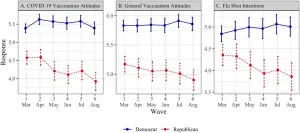Methane release rapidly increases in the wake of the melting ice sheets
2021-04-29
(Press-News.org) Ice ages are not that easy to define. It may sound intuitive that an ice age represents a frozen planet, but the truth is often more nuanced than that.
An ice age has constant glaciations and deglaciations, with ice sheets pulsating with the rhythm of changing climate. These giants have been consistently waxing and waning, exerting, and lifting pressure from the ocean floor.
Several studies also show that the most recent deglaciation, Holocene (approximately 21ka-15ka ago) of the Barents Sea has had a huge impact on the release of methane into the water. A most recent study in Geology looks even further into the past, some 125 000 years ago, and contributes to the conclusion: Melting of the Arctic ice sheets drives the release of the potent greenhouse gas methane from the ocean floor.
"In our study, we expand the geological history of past Arctic methane release to the next to last interglacial, the so-called Eemian period. We have found that the similarities between the events of both Holocene and Eemian deglaciation advocate for a common driver for the episodic release of geological methane - the retreat of ice sheets." says researcher Pierre-Antoine Dessandier, who conducted this study as a postdoctoral fellow at CAGE Centre for Arctic Gas Hydrate Environment and Climate at UiT The Arctic University of Norway.
Seeing thousands of years of methane release in tiny shells
The study is based on measurements of different isotopes found in sediment cores collected from the Arctic Ocean. Isotopes are variations of chemical elements, such as carbon and oxygen, in this case. Different isotopes of the same element have different weight and interact with other chemical elements in the environment in specific ways. This means that the composition of certain isotopes is correlated to the environmental changes - such as temperature or amount of methane in the water column or within the sediment. Isotopes are taken up and stored in the shells of tiny organisms called foraminifera and in that way get archived in the sediments for thousands of years as the tiny creatures die. Also, if methane was released for longer periods of time, the archived shells get an overgrowth of carbonate which in itself also can be tested for isotopes.
"The isotopic record showed that as the ice sheet melted and pressure on the seafloor lessened during the Eemian, methane was released in violent spurts, slow seeps, or a combination of both. By the time the ice disappeared completely, some thousands of years later, methane emissions had stabilized." says Dessandier.
Where did the methane come from?
Arctic methane reservoirs consist of gas hydrates and free gas. Gas hydrates are solids, usually methane gas, frozen in a cage with water, and extremely susceptible to pressure and temperature changes in the ocean. These reservoirs are potentially large enough to raise atmospheric methane concentrations if released during the melting of glacial ice and permafrost. The Geology study reinforces the hypothesis that the release of this greenhouse gas strongly correlates with the melting of the ice sheets. It is also an example of the past showing what the future may hold.
"The present-day acceleration of Greenlands ice melt is an analogue to our model. We believe that the future release of methane from below and nearby these ice sheets is likely." Says Dessandier
Increasing methane emissions are a major contributor to the rising concentration of greenhouse gases in Earth's atmosphere, and are responsible for up to one-third of near-term global heating. During 2019, about 60% (360 million tons) of methane released globally was from human activities, while natural sources contributed about 40% (230 million tons).
How much methane eventually made it to the atmosphere during the Eemian and Holocene deglaciations remains uncertain. Part of the problem in quantifying this are the microbial communities that live on the seafloor and in the water and use methane to survive.
But both those past deglaciations happened over thousands of years, while the current retreat of the ice sheets is unprecedentedly rapid according to the geological record.
"The projections of future climate change should definitely include the release of methane following in the wake of diminishing ice sheets. Past can be used to better inform the future."
INFORMATION:
[Attachments] See images for this press release:

ELSE PRESS RELEASES FROM THIS DATE:
2021-04-29
New Haven, Conn. -- The choice between two non-invasive diagnostic tests is a common dilemma in patients who present with chest pain. Yale cardiologist Rohan Khera, MD, MS, and colleagues have developed ASSIST©, a new digital decision-aiding tool.
By applying machine learning techniques to data from two large clinical trials, this new tool identifies which imaging test to pursue in patients who may have coronary artery disease or CAD, a condition caused by plaque buildup in the arterial wall.
The new tool, described in a study published April 21 in the European Heart Journal, focuses on the long-term outcome for a given patient.
"There are strengths and limitations ...
2021-04-29
Individuals who self-identify as Republicans became more skeptical of a potential COVID-19 vaccine and other inoculations, such as the flu shot, over the course of the pandemic, reveals a new study by the University of California San Diego’s Rady School of Management.
The paper, published in PLOS ONE, measured general attitudes toward vaccines and assessed whether study participants would get a potential COVID-19 vaccine as well as the seasonal flu shot. It also gauged trust in media.
“We found Republicans became increasingly vaccine hesitant and less trusting of media from March to August of 2020, while Democrats’ views on ...
2021-04-29
LONDON, ON - In a published study, a team from Lawson Health Research Institute has found that a simple device can reduce swelling after kidney transplantation. The geko™ device, manufactured by Sky Medical Technology Ltd and distributed in Canada by Trudell Healthcare Solutions Inc., is a muscle pump activator which significantly improves blood flow by stimulating the body's 'muscle pumps.' Patients using the device following kidney transplantation experienced shorter hospital stays and reduced surgical site infections by nearly 60 per cent.
Kidney and simultaneous pancreas-kidney transplantations ...
2021-04-29
Scientists have recreated the reaction by which carbon isotopes made their way into different organic compounds, challenging the notion that organic compounds, such as amino acids, were formed by isotopically enriched substrates. Their discovery suggests that the building blocks of life in meteorites were derived from widely available substrates in the early solar system.
Their findings were published online in Science Advances on April 28, 2021.
Carbonaceous meteorites contain the building blocks of life, including amino acids, sugars, and nucleobases. These ...
2021-04-29
Scientists from Stony Brook University and the Max Planck Institute of Animal Behavior have pieced together a timeline of how brain and body size evolved in mammals over the last 150 million years. The international team of 22 scientists, including biologists, evolutionary statisticians, and anthropologists, compared the brain mass of 1400 living and extinct mammals. For the 107 fossils examined--among them ancient whales and the oldest Old World monkey skull ever found--they used endocranial volume data from skulls instead of brain mass data. The brain measurements were then analyzed along with body size ...
2021-04-29
Within the past decade, next-generation sequencing technologies have revolutionized the way in which genetic data are generated and analyzed. In the field of phylogenetics, this has meant that researchers are rapidly reconstructing the tree of life, a goal that biologists have been working toward since Darwin sketched the first phylogeny in his notebook in 1837.
Yet despite the relative ease with which DNA can now be sequenced in large quantities, scientists must first extract that DNA from an organism, often relying on vast numbers of curated specimens ...
2021-04-29
DALLAS, April 29, 2021 -- Health care professionals should consider prescribing medication for patients with slightly elevated blood pressure if levels do not decrease after six months of healthy lifestyle changes, according to a new scientific statement from the American Heart Association. The statement, published today in the Association's journal Hypertension, fills a gap in guideline recommendations by addressing how to manage untreated, stage 1 high blood pressure - levels of 130-139/80-89 mm Hg - that was not fully addressed in the 2017 treatment guidelines.
The 2017 American College of Cardiology/American Heart Association Blood Pressure Management ...
2021-04-29
Eye contact plays a fundamental role in human communication and relationships. When we look into each other's eyes, we show that we are paying attention to each other. However, we do not only look at each other but also at our four-legged companions. According to new research by Hungarian ethologists, at least four independent traits affect dogs' ability to establish eye contact with humans. Short-headed, cooperative, young, and playful dogs are the most likely to look into the human eye.
Dogs adapted uniquely well to live with humans, and communication plays a vital ...
2021-04-29
Less than one percent of people in the United States use kratom, a plant-based substance commonly used to manage pain and opioid withdrawal, according to a study published in the American Journal of Preventive Medicine. However, the use of kratom--which is legal but carries the risk of addiction and harmful side effects--is more prevalent among people who use other drugs, particularly those with opioid use disorder.
Derived from a tree native to Southeast Asia, kratom can be taken as a pill, capsule, or extract, or brewed as a tea. It acts on the brain's opioid receptors; at low doses, kratom is a stimulant, while at higher doses, it can relieve pain. Some people report using kratom as a substitute for opioids in an effort ...
2021-04-29
CHAMPAIGN, Ill. -- Researchers have created a new, open-access tool that allows doctors and scientists to evaluate infant brain health by assessing the concentration of various chemical markers, called metabolites, in the brain. The tool compiled data from 140 infants to determine normal ranges for these metabolites.
Published in the journal NMR in Biomedicine, the study describes an easier and more reliable way to evaluate metabolite concentrations in the infant brain than was previously available, said study lead Ryan Larsen, a researcher at the Beckman Institute for Advanced Science and Technology at the University of Illinois Urbana-Champaign.
Metabolites play an important role in normal brain growth, development and function, said study co-author ...
LAST 30 PRESS RELEASES:
[Press-News.org] Methane release rapidly increases in the wake of the melting ice sheets






